Knockdown of cytosolic glutaredoxin 1 leads to loss of mitochondrial membrane potential: implication in neurodegenerative diseases
- PMID: 18560520
- PMCID: PMC2426930
- DOI: 10.1371/journal.pone.0002459
Knockdown of cytosolic glutaredoxin 1 leads to loss of mitochondrial membrane potential: implication in neurodegenerative diseases
Abstract
Mitochondrial dysfunction including that caused by oxidative stress has been implicated in the pathogenesis of neurodegenerative diseases. Glutaredoxin 1 (Grx1), a cytosolic thiol disulfide oxido-reductase, reduces glutathionylated proteins to protein thiols and helps maintain redox status of proteins during oxidative stress. Grx1 downregulation aggravates mitochondrial dysfunction in animal models of neurodegenerative diseases, such as Parkinson's and motor neuron disease. We examined the mechanism underlying the regulation of mitochondrial function by Grx1. Downregulation of Grx1 by shRNA results in loss of mitochondrial membrane potential (MMP), which is prevented by the thiol antioxidant, alpha-lipoic acid, or by cyclosporine A, an inhibitor of mitochondrial permeability transition. The thiol groups of voltage dependent anion channel (VDAC), an outer membrane protein in mitochondria but not adenosine nucleotide translocase (ANT), an inner membrane protein, are oxidized when Grx1 is downregulated. We then examined the effect of beta-N-oxalyl amino-L-alanine (L-BOAA), an excitatory amino acid implicated in neurolathyrism (a type of motor neuron disease), that causes mitochondrial dysfunction. Exposure of cells to L-BOAA resulted in loss of MMP, which was prevented by overexpression of Grx1. Grx1 expression is regulated by estrogen in the CNS and treatment of SH-SY5Y cells with estrogen upregulated Grx1 and protected from L-BOAA mediated MMP loss. Our studies demonstrate that Grx1, a cytosolic oxido-reductase, helps maintain mitochondrial integrity and prevents MMP loss caused by oxidative insult. Further, downregulation of Grx1 leads to mitochondrial dysfunction through oxidative modification of the outer membrane protein, VDAC, providing support for the critical role of Grx1 in maintenance of MMP.
Conflict of interest statement
Figures
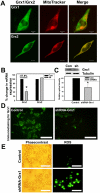

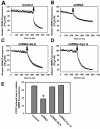

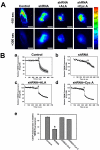


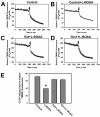
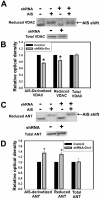
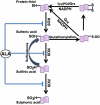
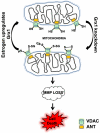
Similar articles
-
Downregulation of glutaredoxin but not glutathione loss leads to mitochondrial dysfunction in female mice CNS: implications in excitotoxicity.Neurochem Int. 2007 Jul;51(1):37-46. doi: 10.1016/j.neuint.2007.03.008. Epub 2007 Apr 5. Neurochem Int. 2007. PMID: 17512091
-
Cardiac damage and dysfunction in diabetic cardiomyopathy are ameliorated by Grx1.Genet Mol Res. 2016 Sep 19;15(3). doi: 10.4238/gmr.15039000. Genet Mol Res. 2016. PMID: 27706757
-
Thioltransferase (glutaredoxin) mediates recovery of motor neurons from excitotoxic mitochondrial injury.J Neurosci. 2002 Oct 1;22(19):8402-10. doi: 10.1523/JNEUROSCI.22-19-08402.2002. J Neurosci. 2002. PMID: 12351714 Free PMC article.
-
Critical Roles of Glutaredoxin in Brain Cells-Implications for Parkinson's Disease.Antioxid Redox Signal. 2019 Apr 1;30(10):1352-1368. doi: 10.1089/ars.2017.7411. Epub 2018 Jan 5. Antioxid Redox Signal. 2019. PMID: 29183158 Free PMC article. Review.
-
Neurolathyrism: mitochondrial dysfunction in excitotoxicity mediated by L-beta-oxalyl aminoalanine.Neurochem Int. 2002 May;40(6):505-9. doi: 10.1016/s0197-0186(01)00121-8. Neurochem Int. 2002. PMID: 11850107 Review.
Cited by
-
Mitochondrial thiols in the regulation of cell death pathways.Antioxid Redox Signal. 2012 Dec 15;17(12):1714-27. doi: 10.1089/ars.2012.4639. Epub 2012 Jun 11. Antioxid Redox Signal. 2012. PMID: 22530585 Free PMC article. Review.
-
Protein-thiol oxidation and cell death: regulatory role of glutaredoxins.Antioxid Redox Signal. 2012 Dec 15;17(12):1748-63. doi: 10.1089/ars.2012.4644. Epub 2012 Jun 5. Antioxid Redox Signal. 2012. PMID: 22530666 Free PMC article. Review.
-
Plant toxin β-ODAP activates integrin β1 and focal adhesion: A critical pathway to cause neurolathyrism.Sci Rep. 2017 Jan 17;7:40677. doi: 10.1038/srep40677. Sci Rep. 2017. PMID: 28094806 Free PMC article.
-
SR/ER-mitochondrial local communication: calcium and ROS.Biochim Biophys Acta. 2009 Nov;1787(11):1352-62. doi: 10.1016/j.bbabio.2009.06.004. Epub 2009 Jun 13. Biochim Biophys Acta. 2009. PMID: 19527680 Free PMC article. Review.
-
Nitrated {alpha}-synuclein-induced alterations in microglial immunity are regulated by CD4+ T cell subsets.J Immunol. 2009 Apr 1;182(7):4137-49. doi: 10.4049/jimmunol.0803982. J Immunol. 2009. PMID: 19299711 Free PMC article.
References
-
- Bambrick LL, Fiskum G. Mitochondrial dysfunction in mouse trisomy 16 brain. Brain Res. 2008;1188:9–16. - PubMed
-
- Orth M, Schapira AH. Mitochondria and degenerative disorders. Am J Med Genet. 2001;106:27–36. - PubMed
-
- Solans A, Zambrano A, Rodriguez M, Barrientos A. Cytotoxicity of a mutant huntingtin fragment in yeast involves early alterations in mitochondrial OXPHOS complexes II and III. Hum Mol Genet. 2006;15:3063–3081. - PubMed
Publication types
MeSH terms
Substances
LinkOut - more resources
Full Text Sources
Medical
Molecular Biology Databases

